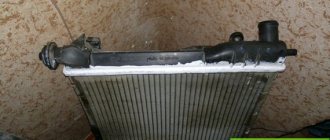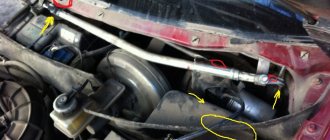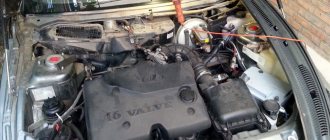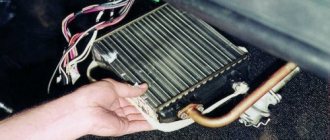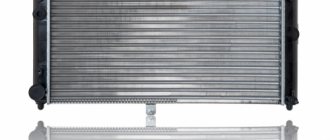What does a car stove consist of and why change the radiator?
In the design of a car heater, the radiator, which plays the role of a heat exchanger, is a key element through which the temperature in the cabin increases (heating). The heater is designed not only to warm up the interior during the cold season, but also to prevent the windows from fogging, thereby impairing visibility and visibility.
The design of a car stove consists of the following elements:
- Plastic case, inside of which the main components are located
- Radiator - also known as a heat exchanger or convector
- Fan powered by an electric motor. Provides targeted air flow through the radiator and through the air ducts into the cabin
- The control valve is an important element through which the coolant supply to the radiator is opened and closed. The coolant is antifreeze, coolant or antifreeze. On Lanos, Sens and Chance, the role of the heater tap is played by a damper, through which the channel for supplying air through the heat exchanger opens and closes
- Pipes and air ducts
In addition, do not forget about the controls for turning on and setting the stove (they are called controls), which on a Lanos car are located in the central part of the dashboard. These are switches through which the fan is turned on, its rotation speed is adjusted, the direction of flow is heated the windshield, side windows or the supply of warm air into the cabin.
The design diagram of a car heater is shown in the photo above. The operating principle of the device is simple, and it is based on the fact that heated antifreeze circulating through the system is supplied to the stove radiator. The plates, honeycombs or lamellas of the radiator heat up, and this heat is used for rational purposes to heat the interior. A fan is used to circulate heat from the heater core into the cabin. You can turn on the stove only after the engine temperature reaches at least 50 degrees.
This is interesting!
Why can't you turn on the heater on a cold engine? This will cause the engine to warm up longer, which will cause increased fuel consumption and other negative consequences. That is why it is necessary to exclude the possibility of turning on the stove until the engine warms up to a minimum temperature of 50-60 degrees.
The tightness of the tubes or what is a two-row and three-row radiator
When choosing, you may be faced with the fact that heat exchangers for the stove come in two types depending on the way the tubes are arranged.
They are called two-row and three-row. The difference between them is significant, and it is reflected mainly in the performance of the device. What is better to put on Lanos? Is it worth buying a three-row stove radiator or is a two-row one enough? These questions haunt Lanos owners, and so it’s time to sort them out. Double-row units have lower thermal output, however, for the heating system of a Lanos car, they are quite sufficient, provided that all components are in good working order.
The main advantage of the Lanos, Sense and Chance heating system is the presence of a switch for air absorption - external and from the cabin (recovery). To warm up the interior at low temperatures, you should switch the regulator to recovery mode. This way, not cold air from the street will be supplied to the system, but warm air, thereby increasing the rate of heating of the interior. Thanks to this switch, it is not at all necessary to install a three-row heater radiator on Lanos.
This is interesting! On Zhiguli cars, air is absorbed directly from the street, so the double-row radiators of the stove cope with their purpose by 50%, which is especially evident when driving on the highway. It is recommended to install three-row heat exchangers on these cars.
Interior heating system Chevrolet Lanos Sens and Chance
Lanos cars were produced with two types of heating systems - independent and with air conditioning. On Lanos, the stove is located in the lower part in the center of the console under a plastic casing. It is in the central part of the torpedo that the main component of the stove is located - the heat exchanger. The design diagram of the interior heater of a Chevrolet and Daewoo Lanos car is shown in the photo below.
The diagram shows the following nodes:
- A damper that regulates the distribution of incoming thermal air onto the windows and into the interior
- Distribution top air damper - allows switching between heating and cooling
- Heat exchanger
- A damper through which the air temperature is regulated - cold and hot. This damper replaces the heater valve, which on cars such as Slavuta, VAZ-2101 to VAZ-2109 is used to shut off the coolant supply to the radiator
- Air conditioner radiator
- Fan motor
- The damper through which the air supply into the system is regulated - the suction area. In mode A, air comes from outside, and turning on mode B provides air from the passenger compartment (recirculation mode)
- Lower damper - limiting the flow of cold air into the cabin
- Main heater and air conditioning duct that supplies warm and cold air to the interior
- Branch pipes for blowing windshield and side windows
- Blowing side windows
The operating principle of the Lanos car interior heating system is as follows:
- The air that is directed to the heat exchanger is controlled by damper 4
- Air injection is provided by fan electric motor 6
- The air duct system provides heated air for heating the interior (through the main duct), as well as for heating the windshield and side windows
If the stove does not turn on, then the reason lies in a malfunction of the fan electric motor. If the stove works on Lanos, but at the same time blows cold air, then the causes of the breakdown must be looked for directly in the heat exchanger.
This is interesting!
To extend the life of the heater radiator and engine cooling system, high-quality coolants should be used. In addition to using high-quality coolants, you need to be able to choose them correctly.
Interesting facts about the purpose of a heater radiator in a car
Replacing the heater radiator on a Lada Priora (with and without air conditioning)
Why a heat exchanger is needed in a car's heating system, and how the circuit for supplying warm air to the cabin is arranged, is described in detail in the material - how to replace the heat exchanger of the interior heater of a Chevrolet and Daewoo Lanos. If you are reading this material, you probably know the purpose of this device.
The heater radiator is included in the main engine cooling system. The cooling system consists of two circuits - a large and a small circle. Coolant circulates through the system, for which the pump is responsible. The liquid circulates in a small circle when the engine starts. When the engine warms up to a certain temperature, access to a large circle of the system opens. The thermostat is responsible for opening access to a large circle.
The heater radiator is included in a small circle of the system, so when the engine starts, the heated coolant flows to this device. On Lanos there is no coolant flow control valve, so the fluid circulates in the heater heat exchanger constantly. This allows the driver to turn on the heater as soon as the engine warms up to 50-60 degrees. The engine cooling radiator is included in a large circuit, which provides cooling to the engine after it reaches operating temperature.
This is interesting! The heat exchanger of a car heater is 5 times smaller in size than the engine cooling heat exchanger. Lanos owners often have a question about where the radiator of the Lanos stove is located. It is located in the cabin under the dashboard in the central part. How to get to it and replace it is described in detail in the material on the website.
What heater regulators are installed on Lanos 1.5 and 1.6 and their purpose
On the central panel in the interior of the Lanos car there are regulators through which the heater is turned on, as well as setting and adjusting the operation. Below is a photo showing the controls.
- The regulator by which damper 4 in the diagram above is activated. Provides opening and closing of the channel for supplying air through or bypassing the radiator
- Turning on the fan and rotation speed of the blades
- Regulator through which air flow distribution is adjusted
- Rear window defroster button
- A slider that opens the air supply from outside or from the passenger compartment to the system
- Button for turning the air conditioner on and off - not present on all models, but only on TOP versions of Lanos
The regulators are connected to the dampers via steel cables. Each regulator is controlled regardless of whether the stove is on or not.
This is interesting!
The radiator is a heat exchanger in which coolant flows through the lamellas. The main malfunction of the device is that the integrity of the lamellas is compromised, and antifreeze leaks occur. In this case, you will need to replace the device with a new one.
How to determine a malfunction of the heater radiator on a Chevrolet, ZAZ and Daewoo Lanos
With the onset of cold weather, it is increasingly necessary to use the interior heater in a Lanos, Sense and Chance car. However, sometimes the owners of these cars are faced with the fact that at one moment the stove does not blow warm air, but, on the contrary, cold air or does not work at all. If the fan motor turns on and the stove blows cold air, then the first thing you should do is check the serviceability of the cold and hot air regulator. The cause of the malfunction may be that the damper is jammed or the steel cable is failing. Make sure that these mechanisms are in working order, after which you can assume that the radiator of the Lanos stove has failed.
To make sure that the heater radiator is faulty on Lanos, Sense and Chance, you need to pay attention to the following factors:
- If the heater heat exchanger on a Lanos is faulty, then the first sign of such a fault is fogging of the windows.
How does this relate to a faulty radiator? If the integrity of the heat exchanger is compromised, coolant will enter the cabin and condense on the glass. - The appearance of a pungent odor in the cabin.
This is the smell of antifreeze that enters the cabin due to damage to the radiator. - Rapid consumption of antifreeze - if you notice that you often have to add coolant, then you should make sure that the heat exchanger of the heater is in good condition
The easiest way to make sure that the integrity of the radiator is compromised is to disassemble and inspect it. If the radiator is damaged, the stove will heat up, but the above factors will be present in the cabin. If the stove does not blow warm air in the Lanos’s cabin, then the reasons for this may be the following factors:
- Thermostat malfunction
- Formation of a plug inside the system or radiator - in this case, the stove will not blow warm air
- Clogging of radiator fin channels
- Various debris such as leaves, fluff, dust getting into the honeycombs of the device
Replacing a heating stove radiator is performed when the device fails. Often the reason for the rapid failure of the heater radiator is its fastening. It is realized through the use of plastic fasteners. Often these fasteners break off due to vibrations and temperature changes, which leads to failure of the entire device. If the device's cells are damaged, it must be replaced. To eliminate the possibility of the brackets breaking off, they should be additionally reinforced with metal latches or brackets. How to strengthen the mounting of the heater radiator on Lanos is shown in the photo.
There is also another way to ensure effective fastening of the stove radiator - use self-tapping screws.
To determine that the standard locking latch has broken off, it is not at all necessary to disassemble the floor of the car just to look. To do this, you need to shake the incoming fittings of the stove from the engine compartment. The presence of play means that the latch has broken off, and disassembly will be required to correct the situation.
This is interesting!
If, when you turn on the stove, you feel a flow of cold air in the cabin, you should resort to sealing the plastic housing.
Stove repair
1) For greater convenience of further actions, it is better to remove the entire stove block assembly (photo 23).
2) The block is secured with 5 bolts on the engine side and removing it is not difficult.
3) Disconnect the main pipes.
4) Further disassembly is not difficult; it is time-consuming, since the radiator is hidden by many bolts. If the essence of the problem is that the stove has fallen, then there is no point in unscrewing the entire stove block; it is enough to remove the plastic case that covers the radiator. And then return the terminals to their place.
5) Collection is carried out in reverse order.
Part: Heater radiator 96231949 / GM DAEWOO
How to replace a heater core without removing the dashboard.
Many people are interested in the question: how to replace the heater radiator on a Chevrolet Lanos without removing the dashboard . I won’t say it’s as easy as shelling pears, but there aren’t any particular difficulties.
A lift or pit is required to perform this operation. But you can do without them.
You just need to remove the pipes from the heater radiator and disconnect the connection between the gearshift lever rod and the gearbox, and this is much more convenient to do from below the car.
Many people write that you need to remove one of the seats, or even both. Not at all necessary. Yes, if you remove them there will be more space, and it will be easier to remove the plastic tunnel in the center. But is it worth it?
So let's get started.
First, remove the pipes from the heater radiator and drain the coolant.
Don’t forget to provide some kind of container to collect the liquid, it will come in handy.
Unscrew the clamp securing the gear lever rod. Unscrew the bolt completely. Loosen the clamp and remove the gearbox linkage axle from the rod. It is advisable to mark the joint location so as not to suffer during assembly. We remove the clamp.
If the car does not have air conditioning, you can skip a few paragraphs.
If there is an air conditioner, a fitting is provided in the heater housing to drain condensate from the air conditioner radiator. The fitting is located to the left of the heater radiator pipes. Usually it has an L-shaped rubber pipe directed downwards.
Let's jump ahead a little.
In order to remove the casing covering the radiator, the casing must be lowered downwards (it is connected to the heater body using a tongue-and-groove method). But the fitting does not allow this to be done. To pull the fitting out of the engine shield, you need to pull the casing towards you, but the “groove-tenon” connection does not allow this to be done.
We have to use force. Sometimes it is possible to accomplish this feat, but usually the casing breaks, sometimes even in several places. Of course, it can be glued together, but during installation it will break again.
What is needed to replace the heater radiator on Lanos Sense and Chance
It is worth noting that after literally 3-5 years of using a Lanos car, problems arise with the heating system. Most often this happens precisely because of a malfunction of the heater radiator. If the check shows that the heat exchanger of the heater has indeed failed, then it should be replaced. Moreover, this matter cannot be delayed, since inhaling coolant vapors is very dangerous and can cause respiratory poisoning for the driver and passengers.
How can I replace the heater radiator on Lanos? There are two ways to do this. The first involves visiting a service station, and at the same time eliminates the need to delve into the device yourself. This method is good for everyone, except for the cost. For such repairs, the master will ask for at least 2-3 thousand rubles. Additionally, during the repair process, other defects may be discovered, for which you will also have to pay separately. The second method is not so much costly financially as it is physically. Absolutely every owner of these cars can replace the heater radiator on Lanos, Sense and Chance with their own hands. Moreover, there are different ways to do this - with and without dismantling the dashboard.
In order to replace devices on a car, you will need the following tools:
- Set of keys and screwdrivers
- Pliers
- Screwdriver with flexible shaft
- Sealant
The most important thing is that it will take a lot of time. Take one day to remove and replace the heater core on your car yourself. This will save money, which can be spent on purchasing a more reliable heater radiator. Which is better to install a heater radiator on Lanos is described in detail here. Not many people know how to remove the heater radiator on a Chevrolet Lanos. Most people know that this work is painstaking, and therefore they choose the option of replacing it at a car service center. After reading the instructions, you will be able to independently change the heater radiators on Lanos, Chance and Sens, and at the same time save your money.
Replacement without removing panel
The traditional method is only suitable if we are only changing the radiator. If you decide to carry out a complete inspection of the heater, and in addition to the heat exchanger itself, check and adjust the dampers, change the seals, then in this case you will have to remove the front panel to provide full access to the housing for disassembling it.
Tools and equipment
To perform the replacement using a method that does not involve removing the front panel, you will need:
- a new radiator (repairing a Chevrolet Lanos radiator is impossible and therefore it is easier to purchase and install a new part);
- rubber tubes of the stove (with which the heat exchanger is connected to the cooling system);
- set of keys and sockets (standard sizes);
- screwdrivers (phillips, flat, long, short);
- rags;
- antifreeze;
- flashlight.
To simplify disassembly, the presence of a flexible extension cord, a set of Phillips and flat bits, and a wrench with a ratchet mechanism (found in tool kits for car repairs) will make it possible. Using a flexible extension, you can easily reach and unscrew fasteners located in hard-to-reach places.
Technology of work execution
Having prepared the necessary equipment, we begin to work. At the same time, one of the disassembly stages involves working under the car, so an inspection hole is also needed.

